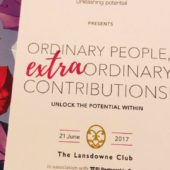 Advances in achieving gender balance in the corporate space are slow, at best. Despite the deafening cries for progress towards gender parity, progress is, indeed, evading us. The latest gender pay gap statistics in the UK prove the point, with the largest pay gap reported in the construction sector at 25%, followed by finance and insurance sector at 22% and education at 20%. The World Economic Forum predicts it will take the world another 217 years to reach parity, and many other reports show that, while we appear to be inching closer to a more diverse and inclusive world, progress is, well, patchy and sometimes questionable.
Advances in achieving gender balance in the corporate space are slow, at best. Despite the deafening cries for progress towards gender parity, progress is, indeed, evading us. The latest gender pay gap statistics in the UK prove the point, with the largest pay gap reported in the construction sector at 25%, followed by finance and insurance sector at 22% and education at 20%. The World Economic Forum predicts it will take the world another 217 years to reach parity, and many other reports show that, while we appear to be inching closer to a more diverse and inclusive world, progress is, well, patchy and sometimes questionable.
I have to ask myself the question why? After all, in my conversations with clients and other companies, it seems diversity and inclusion is an important part of the business agenda, and gender balance even more so. Most have already spent copious resources on various initiatives that intend to support and advance women – and, more broadly, diversity – within the organisation. And yet, few would claim genuine parity at all levels.
If you ask me, part of the problem is the belief that we’re doing all the right things whereas the truth is that most of the current initiatives fail to shift the dial on diversity.
Here are my 3 reasons for it:
All female leadership and other initiatives
 The intentions behind programmes that support the advancement of women in the organisation are great, but there are a number of problems with this approach: (i) when programmes cater to women only, the overarching message the company is sending to its women is that there is something wrong with them and that it is trying to ‘fix’ them. This is particularly true of leadership programmes which intimate that women need more development than men to become leaders; (ii) even successful female-only initiatives tend to backfire because, to the extent they succeed to motivate and engage women, by the time women go back to their unchanged work environment, frustration starts to set in as they continue to perform in an environment that fails to recognise the value of their authentic contribution; and (iii) initiatives that are aimed at a specific segment of the population tend to be divisive and fail to attract the requisite amount of support and inclusion to harness lasting progress.
The intentions behind programmes that support the advancement of women in the organisation are great, but there are a number of problems with this approach: (i) when programmes cater to women only, the overarching message the company is sending to its women is that there is something wrong with them and that it is trying to ‘fix’ them. This is particularly true of leadership programmes which intimate that women need more development than men to become leaders; (ii) even successful female-only initiatives tend to backfire because, to the extent they succeed to motivate and engage women, by the time women go back to their unchanged work environment, frustration starts to set in as they continue to perform in an environment that fails to recognise the value of their authentic contribution; and (iii) initiatives that are aimed at a specific segment of the population tend to be divisive and fail to attract the requisite amount of support and inclusion to harness lasting progress.
Appointing a female head to ‘tackle the problem’
 In many cases, executive teams are genuine about their desire to advance women. But they don’t recognise it as a central business priority and look at it as a project to be managed. Having identified it as an issue, they tend to look for the right person to address it which, in many cases, happens to be the one woman on the executive team. I have heard this story so many times.
In many cases, executive teams are genuine about their desire to advance women. But they don’t recognise it as a central business priority and look at it as a project to be managed. Having identified it as an issue, they tend to look for the right person to address it which, in many cases, happens to be the one woman on the executive team. I have heard this story so many times.
These women, or other senior women in the organisation, are anointed as Head of People, or Gender Diversity Sponsor or similar, and are expected to single-handedly ‘solve the issue’. If they’re lucky, the board will agree to authorise resources to support the position in the form of additional help and/or budget. Yet in most cases, all the resources are going to be insufficient because the ‘problem’ cannot be solved by one or few individuals, and certainly not this particular ‘problem’ (because it’s not so much a problem but an unexplored opportunity).
Parachuting women into senior roles
 In many cases, gender imbalance exists primarily at the very top. Many companies tackle the issue by bringing in lateral hires as they don’t appear to have their own senior female pipeline to address the disparity. Sadly, this is one of the worst solutions to this issue. Having spoken to a number of corporates who have taken such measures it becomes clear very quickly that there is no substitute for ‘growing your own’. Attracting senior women from elsewhere is, at best, a temporary solution. These freshly-hired women – like the the women who have been at the company for years – will be exposed to the very same culture that failed to produce the senior pipeline in the first instance. As a result, the new senior female leaders are likely to become disenchanted with their roles as they come to realise that they are not hired for their expertise and contribution but, instead (to put it bluntly), to tick a box. Even if they do succeed in making a contribution to the company that is genuinely valued, companies have to carefully guard these women from being hired away by others with a similar agenda. The reality is that there are not that many senior women out there who seem to satisfy the existing requirements for board or senior level hires (although, of course, many more women can indeed to the job) so, unless companies develop their own female leadership pipeline, they stand to lose those recent hires to others that have a similar approach to gender balance.
In many cases, gender imbalance exists primarily at the very top. Many companies tackle the issue by bringing in lateral hires as they don’t appear to have their own senior female pipeline to address the disparity. Sadly, this is one of the worst solutions to this issue. Having spoken to a number of corporates who have taken such measures it becomes clear very quickly that there is no substitute for ‘growing your own’. Attracting senior women from elsewhere is, at best, a temporary solution. These freshly-hired women – like the the women who have been at the company for years – will be exposed to the very same culture that failed to produce the senior pipeline in the first instance. As a result, the new senior female leaders are likely to become disenchanted with their roles as they come to realise that they are not hired for their expertise and contribution but, instead (to put it bluntly), to tick a box. Even if they do succeed in making a contribution to the company that is genuinely valued, companies have to carefully guard these women from being hired away by others with a similar agenda. The reality is that there are not that many senior women out there who seem to satisfy the existing requirements for board or senior level hires (although, of course, many more women can indeed to the job) so, unless companies develop their own female leadership pipeline, they stand to lose those recent hires to others that have a similar approach to gender balance.
These are but a few reasons current initiatives fail to advance gender balance at work, and there are a number of others. If you would like to explore this topic further, email us for a longer version of this post.





 How are you feeling about your career? Do you feel you are progressing as you want to? Importantly, do you enjoy the environment you work in?
How are you feeling about your career? Do you feel you are progressing as you want to? Importantly, do you enjoy the environment you work in?
 At Voice At The Table, we’ve been working on developing inclusive cultures for some time now: identifying the starting point, describing the look and feel of an inclusive workplace, and supporting our clients in designing and developing their own inclusive and diverse teams.
At Voice At The Table, we’ve been working on developing inclusive cultures for some time now: identifying the starting point, describing the look and feel of an inclusive workplace, and supporting our clients in designing and developing their own inclusive and diverse teams.


 We invited delegates representing a myriad of industries (including law, banking, insurance, the armed forces, consulting, engineering, and tech) to explore how, as individual contributors, they can bring their whole selves to work.
We invited delegates representing a myriad of industries (including law, banking, insurance, the armed forces, consulting, engineering, and tech) to explore how, as individual contributors, they can bring their whole selves to work. ote speaker, Miriam Gonzaléz Durantéz talked of the importance of respecting one another, both at work and at home. Respect evidences itself not just by being polite and kind but by allowing the other person the same liberties and entitlements as one allows himself or himself.
ote speaker, Miriam Gonzaléz Durantéz talked of the importance of respecting one another, both at work and at home. Respect evidences itself not just by being polite and kind but by allowing the other person the same liberties and entitlements as one allows himself or himself. We then heard from a panel of speakers, including Claire Bennett, a former professional fencing athlete, about integrating skills they developed in personal passions into their daily work routines. Claire, who now helps former professional athletes to transition into other professions, frequently falls back on the skills she developed as an elite athlete. Skills like resilience, motivation, endurance, commitment, drive and initiative are the foundation of every elite athlete which will serve any of us working for a successful business.
We then heard from a panel of speakers, including Claire Bennett, a former professional fencing athlete, about integrating skills they developed in personal passions into their daily work routines. Claire, who now helps former professional athletes to transition into other professions, frequently falls back on the skills she developed as an elite athlete. Skills like resilience, motivation, endurance, commitment, drive and initiative are the foundation of every elite athlete which will serve any of us working for a successful business. Chuck Stephens of Google shared with us ways in which he inspires employees to bring their whole selves to work. Having observed that certain unwanted consequences disappear once they have been openly highlighted, Chuck and the company emphasise these ramifications, allowing employees to self-manage their own behaviours.
Chuck Stephens of Google shared with us ways in which he inspires employees to bring their whole selves to work. Having observed that certain unwanted consequences disappear once they have been openly highlighted, Chuck and the company emphasise these ramifications, allowing employees to self-manage their own behaviours.



 I’ve always thought that there’s too much emphasis in the world on highly talented, intelligent and accomplished people. Sure, it’s important to recognise and revere them – after all, these are the people who keep notching the progress dial forward for all of us.
I’ve always thought that there’s too much emphasis in the world on highly talented, intelligent and accomplished people. Sure, it’s important to recognise and revere them – after all, these are the people who keep notching the progress dial forward for all of us.